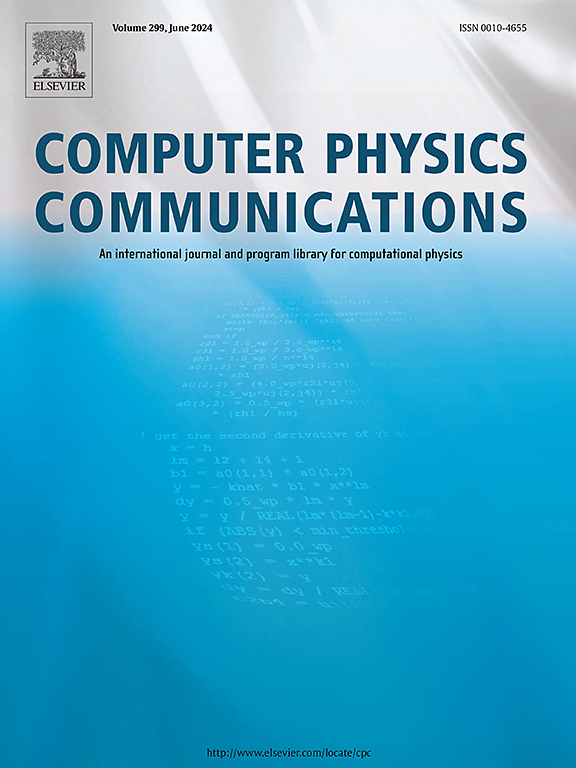QUANTUM ESPRESSO implementation of the RPA-based functional
IF 7.2
2区 物理与天体物理
Q1 COMPUTER SCIENCE, INTERDISCIPLINARY APPLICATIONS
引用次数: 0
Abstract
We detail our implementation of the random-phase-approximation based functional (RPAF) derived in Ref. [1] for the QUANTUM ESPRESSO (QE) package. We also make available in the Computer Physics Communications library the source files which are required in order to apply this functional within QE. We also provide the corresponding RPAF projector augmented wave (PAW) and ultrasoft pseudopotentials for most elements. Lastly, we benchmark the performance of the RPAF by calculating the equilibrium lattice constant and bulk modulus of a set of the same 60 crystals used by other authors to benchmark other functionals for both PAW and ultrasoft pseudopotentials. We find that the RPAF performs better overall as compared to the other most popular functionals.
Program summary
Program Title: Implementation of RPAF functional in QUANTUM ESPRESSO
CPC Library link to program files: https://doi.org/10.17632/y96kpb2dpd.1
Developer's repository link: https://data.mendeley.com/datasets/bg45fjkz2t
Licensing provisions: GPLv3
Programming language: Fortran 90
Nature of problem: To make the RPAF available to be used in DFT calculations.
Solution method: Implementation of RPAF in QUANTUM ESPRESSO.
量子ESPRESSO实现了基于rpa的功能
我们详细介绍了在参考文献[1]中推导的基于随机相位近似的函数(RPAF)在QUANTUM ESPRESSO (QE)包中的实现。我们还在计算机物理通信库中提供了在QE中应用此功能所需的源文件。我们还为大多数元件提供了相应的RPAF投影增强波(PAW)和超软伪电位。最后,我们通过计算一组相同的60个晶体的平衡晶格常数和体积模量来测试RPAF的性能,这些晶体被其他作者用来测试其他函数的PAW和超软伪势。我们发现,与其他最流行的功能相比,RPAF的总体性能更好。程序摘要程序标题:在QUANTUM ESPRESSOCPC库中实现RPAF函数链接到程序文件:https://doi.org/10.17632/y96kpb2dpd.1Developer's存储库链接:https://data.mendeley.com/datasets/bg45fjkz2tLicensing条款:gplv3编程语言:Fortran 90问题性质:使RPAF可用于DFT计算。解决方法:在QUANTUM ESPRESSO中实现RPAF。
本文章由计算机程序翻译,如有差异,请以英文原文为准。
求助全文
约1分钟内获得全文
求助全文
来源期刊

Computer Physics Communications
物理-计算机:跨学科应用
CiteScore
12.10
自引率
3.20%
发文量
287
审稿时长
5.3 months
期刊介绍:
The focus of CPC is on contemporary computational methods and techniques and their implementation, the effectiveness of which will normally be evidenced by the author(s) within the context of a substantive problem in physics. Within this setting CPC publishes two types of paper.
Computer Programs in Physics (CPiP)
These papers describe significant computer programs to be archived in the CPC Program Library which is held in the Mendeley Data repository. The submitted software must be covered by an approved open source licence. Papers and associated computer programs that address a problem of contemporary interest in physics that cannot be solved by current software are particularly encouraged.
Computational Physics Papers (CP)
These are research papers in, but are not limited to, the following themes across computational physics and related disciplines.
mathematical and numerical methods and algorithms;
computational models including those associated with the design, control and analysis of experiments; and
algebraic computation.
Each will normally include software implementation and performance details. The software implementation should, ideally, be available via GitHub, Zenodo or an institutional repository.In addition, research papers on the impact of advanced computer architecture and special purpose computers on computing in the physical sciences and software topics related to, and of importance in, the physical sciences may be considered.
 求助内容:
求助内容: 应助结果提醒方式:
应助结果提醒方式:


